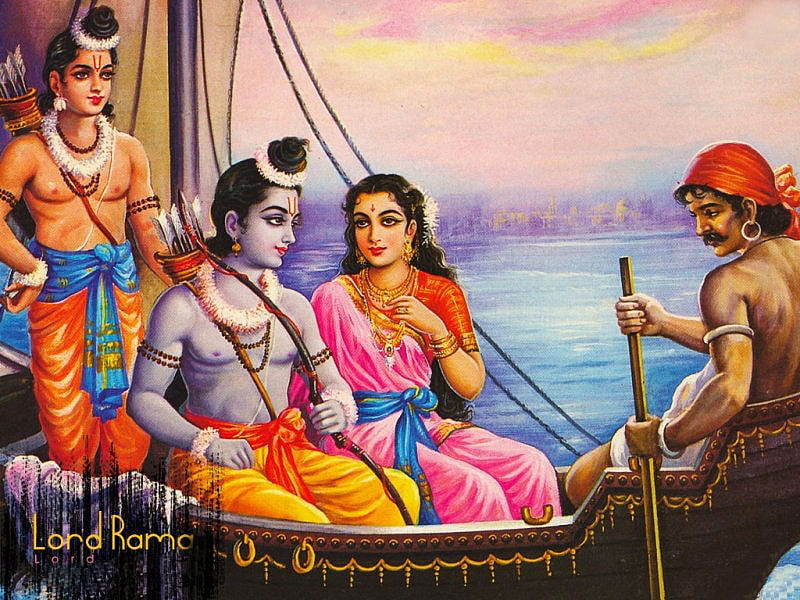Married couples pray for a son like Rama. Young, unmarried women pray for a husband like Rama. People pray for a ruler like Rama. Rama, the 7th incarnation of Vishnu, is seen as the ideal man or Maryada purushottam, who represents the best traits and virtues that a man should possess.
Rama Navami celebrates Rama’s birthday. It falls on the 9th and last day of the Chaitra Navratri festival in the month of March or April. It is also the 9th day of Shukla Paksha in the month of Chaitra, which is the first month in the Hindu calendar.
Rama’s Birth and Purpose
Rama was born to King Dasharatha of Ayodhya and Kausalya, one of the 3 wives of the king. The king had no children for a long time. Finally, he decided to perform a Yagna and please the gods so that he would beget an heir. From the yagna fire emerged a pot of divine kheer, which the queens partook. Soon, all of them delivered sons. Lakshmana, Bharata, and Shatrughna were Rama’s brothers.
All of them lived happily. Rama married Sita, the daughter of King Janaka. But Kaikeyi, one of the queens, wanted her son, Bharata, to become the crown prince. As the king owed her some boons, she demanded that he exile Rama to the forest and make Bharata the crown prince. Heartbroken, Dasharatha died soon after granting the boons. While Rama and Sita, along with Lakshmana, were living in the forest, Ravana, the demon king of Lanka, abducted Sita. Rama, along with an army of monkeys led by Hanuman and bears led by Jambavan, went to war and rescued Sita. In the battle, Ravana was killed.
Thus, Rama’s mission – destroy Adharma and restore Dharma – was accomplished. After returning from exile, he was crowned the king, and he ruled Ayodhya for many years.
Significance of Rama Navami
Like many other Hindu religious festivals, Rama Navami celebrates the victory of good over evil. Rama is a very popular Hindu deity, so this is one of the major festivals in the country. Hindus living abroad, too, celebrate it. The festival is a time for introspection and spiritual contemplation.
Rituals of Rama Navami
Rama Katha (story of Rama) recitals, including stories from the Ramayana, form an important ritual for Rama Navami. Vaishnava Hindus go to the temple or pray at home. Some take part in a bhajan or kirtan singing session with music as a part of the Pooja and Arti. Other devotees wash miniature statues of the infant Rama and clothe them. Then they place them in cradles. There will be charitable events like Annadaanam (feeding the poor). Many observe a fast on this day as they believe it will help them attain salvation. Surya, or the Sun god, is also worshipped on this day, as Rama belonged to the Ikshvaku dynasty, whose founder was King Ikshvaku, the son of Surya, the Sun god. Hence, Rama is also called “Suryavanshi” (from the race of Surya).
Rama Navami was one of the few festivals that lower caste people were permitted to celebrate in ancient times.
Cities that feature in the Ramayana and Rama’s life witness grand celebrations during the festival. They include Ayodhya (Uttar Pradesh), Rameswaram (Tamil Nadu), Sitamarhi (Bihar), and Bhadrachalam (Telangana). In some places, there are Rath-yatras (chariot processions). Some also celebrate the Kalyanotsavam (wedding anniversary) of Rama and Sita on this day.
Whereas Hindus love Krishna (another avatar of Vishnu) for his mischievous pranks, they adore Rama for his virtues like kindness, compassion, sense of fairness and justice, etc. Rama is the god that most people invoke at the time of death. Gandhiji, for instance, uttered the words, ‘Hey Ram’ during his dying moments.
Some Interesting Facts about Rama
Born during the Treta Yuga, Rama is the oldest deity to be worshipped in human form. Treta Yuga supposedly came to an end 1,296,000 years before. Vamana and Parashurama were the other Vishnu avatars in Treta Yuga.
The Guru of Raghuvanshi, Sage Vashistha, gave Rama his name. According to Vasishtha, “Rama” consists of two bijaksharas, “Agni Beej” and “Amrit Beej”. These letters have the ability to provide strength to the mind, body, and soul.
Shiva has said that reciting Rama’s name thrice is like pronouncing the names of thousand deities and gives great benefits.
Rama is the 394th name of Vishnu, as per the Vishnu Sahasranama.
When Sita abandoned her body after the earth swallowed her, Rama took water Samadhi in the Sarayu river.
Lord Rama’s life is the best example of how a person should conduct themselves in life. He was a dutiful and obedient son, a loving and devoted husband, and a just ruler. On Rama Navami, the best way to remember him would be to make a pledge to emulate him.
also read – Leveraging Data Analytics to Drive Webinar Success

